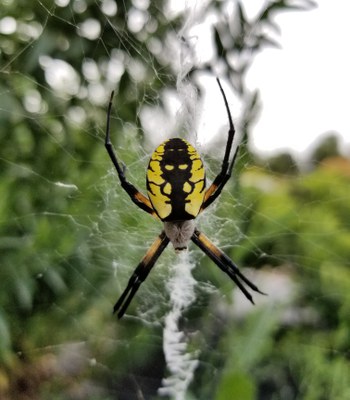Common Natural Enemies of Insect Pests (E2013, March 2021)
Predators
Lacewing or Aphid Lion
Egg (Figure 1): White, laid at the ends of hairlike stalks. One egg per stalk.
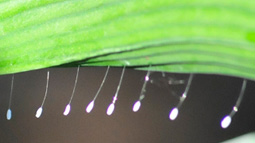
- Figure 1. Egg - lacewing. (Patrick Beauzay, NDSU)
Larva (Figure 2): Called “aphid lion,” about ⅛ to ¾ inch long, mottled gray to brown body and alligatorlike. Large sicklelike mandibles protruding from front of head. Feeds on aphids, about 200 aphids per week, as well as other small insects and mites.
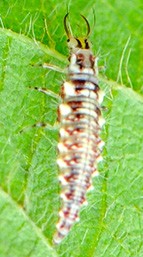
- Figure 2. Larva - lacewing. (Patrick Beauzay, NDSU)
Adult (Figures 3 and 4): About ¾ inch long, slender body with two pairs of long, transparent, netlike wings that fold over the abdomen. Two common species are the green lacewing and the brown lacewing. Feeds on aphids, small caterpillars, other small soft-bodied insects, honeydew, nectar and pollen.
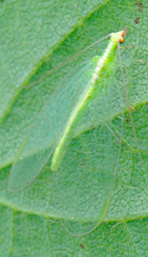
- Figure 3. Adult - green lacewing. (Patrick Beauzay, NDSU)
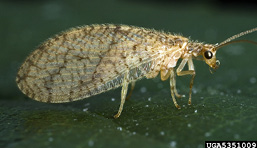
- Figure 4. Adult - brown lacewing. (David Cappaert, Bugwood.org)
Ladybird Beetle or Ladybug
Eggs (Figure 5): ⅛ inch long, cylindrical-shaped, yellow to cream or orange. Laid on leaf surfaces in clusters.
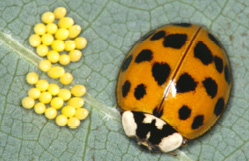
- Figure 5. Eggs and adult - multicolored Asian ladybird beetle. (James Kalisch, Department of Entomology, University of Nebraska)
Larva (Figure 6): Alligator-shaped and about ¼ to ½ inch long, gray to black with orange or yellow spots on body.
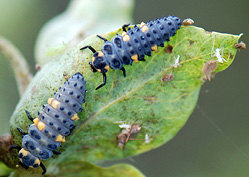
- Figure 6. Larva - lady beetle. (Janet Knodel, NDSU)
Pupa (Figure 7): ¼ inch long, hemispherical shape and often dark or yellow orange. Typically found attached on leaves or stems.
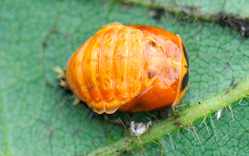
- Figure 7. Pupa - lady beetle. (Patrick Beauzay, NDSU)
Adult (Figures 5 and 8): Round or elongated oval shaped body about ⅛ to ⅓ inch long. Different species of ladybugs vary in color from black, orange, red to pink, and in the number and pattern of spots.
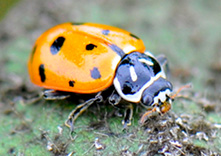
- Figure 8. Adult - lady beetle. (Patrick Beauzay, NDSU)
Larva and adult prey on aphids (one mature larva eats about 30 to 50 aphids per day and one adult about 100 to 300 aphids per day), whiteflies, thrips, mites and other soft-bodied insects.
Syrphid Fly or Hover Fly
Larva (Figure 9): ¼ to ¾ inch long, creamy white, yellowish, green or brown, sluglike in appearance. Head located at the narrow end. Feeds on soft-bodied insects such as aphids and thrips.
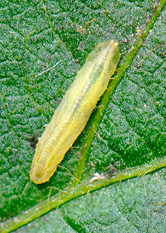
- Figure 9. Larva - syrphid fly. (Patrick Beauzay, NDSU)
Adult (Figure 10): ⅛ to ½ inch long, brightly colored and resemble bees and wasps (yellow-black pattern on abdomen), some hairy but others hairless, large head with reddish or black eyes and two clear wings. They hover over flowers and feed on honeydew, nectar and pollen.
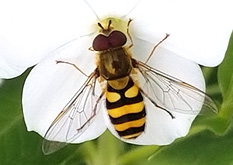
- Figure 10. Adult - syrphid fly. (Veronica Calles-Torrez, NDSU)
Predacious Flower Bug or Minute Pirate Bug
Nymph (Figure 11): Less than 1/10 inch, flat and oval-shaped body. Clear to yellow body for early instar nymph and reddish-brown body for mature nymph. Nymphs do not fly (wings are not developed).
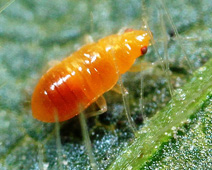
- Figure 11. Nymph - minute pirate bug. (Adam Sisson, Iowa State University, Bugwood.org)
Adult (Figure 12): About ⅛ inch long, flattened and oval elongated body with black and white colors, and brown band in the middle of the body. Wing tips are membranous, clear to white and extend slightly beyond abdomen at rest. Long piercing-sucking mouthparts.
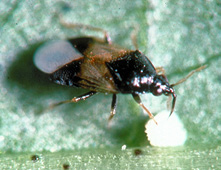
- Figure 12. Adult - minute pirate bug. (John Ruberson, Kansas State University, Bugwood.org)
Nymphs and adults are found on leaves and flowers, and feed on the fluids of insect eggs, small caterpillars, and other soft-bodied pests (aphids, whiteflies, and up to 30 mites per day).
Spiders
Adult (Figures 13 and 14): Various sizes, body shapes and colors (from green to black), two main body sections: cephalothorax (fused head and thorax) and abdomen. Eight legs that are attached to the cephalothorax. Found on ground and vegetation.
Prey: Insects including many insect pests: beetles, crickets, grasshoppers, flies, caterpillars, moths and mosquitoes.
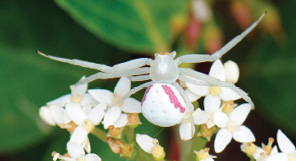
- Figure 14. Goldenrod crab spider. (Patrick Beauzay, NDSU)
Parasitoids
Trichogramma Wasps
Adult (Figure 15): Minute (about 1/50 to 3/64 inch long), often yellow-brown or yellow with noticeably red eyes. Females deposit their eggs inside the eggs of their hosts.
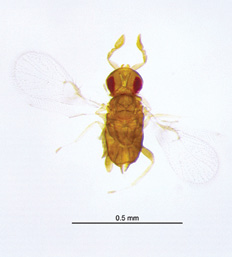
- Figure 15. Adult - Trichogramma wasp. (Patrick Beauzay, NDSU)
Larva: Grublike larva, hatches inside of the host egg and feeds on the host egg; this prevents its host from hatching.
Host: Caterpillar eggs such as European corn borer, corn earworm and cutworm.
Braconid Wasps
Adult (Figure 16): Usually small, less than ⅛ inch long. Often black with black wings, yellow-orange body with transparent wings or red body with black wings. Some with black spots on the margin of wings. Long antennae, slender waist and narrow abdomen. Female wasps have an elongated tubular egg-laying structure (ovipositor). Female deposits a single egg or multiple eggs inside of one host.
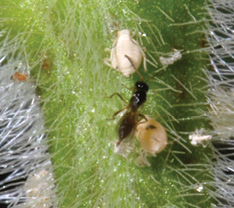
- Figure 16. Adult - Braconid wasp. (Patrick Beauzay, NDSU)
Larva (Figure 17): Grublike in appearance, hatches inside of its host and feeds on host until it is mature. Mature larva pupates inside the host or emerges outside the host to pupate.
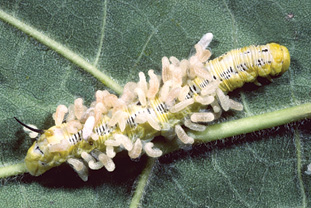
- Figure 17. Braconid wasp larvae emerging from catalpa caterpillar. (James Kalisch, Department of Entomology, University of Nebraska)
Host: Aphids, flies, leaf miners and caterpillars such as European corn borer, armyworm, diamondback moth and hornworms. A parasitized aphid is known as a “mummy.”
Entomopathogenic Fungi/Bacteria/Viral Diseases
Fungi, bacteria and viruses can infect and cause disease in insects and mites. These naturally occurring pathogens often require specific environmental conditions to flourish, such as warm temperatures and high humidity. Some of these pathogens have been developed as commercial microbial pesticides.
Entomophaga grylli (Figure 18) is called “Summit disease” because the infected grasshopper crawls up to the top of a plant stem and embraces it tightly before dying. The abdomen of the grasshopper eventually drops to the soil, releasing millions of fungal spores into the air, which will infect other grasshoppers.
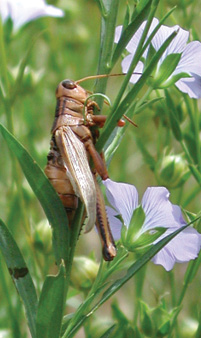
- Figure 18. Grasshopper infected with Entomophaga grylli. (Janet Knodel, NDSU)
Aphids infected with Pandora neoaphidis (Figure 19) become flattened and covered with a pinkish granular coating.
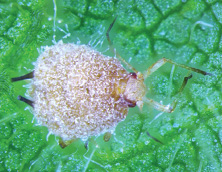
- Figure 19. Soybean aphids infected with Pandora neoaphidis. (Patrick Beauzay, NDSU)
Baculoviruses: A viral-infected thistle caterpillar (Figure 20) is killed by cell replication breaking down the insect’s cell walls. The infected insect appears liquefied. Eventually, the insect’s outer covering ruptures, releasing the liquefied contents and spreading billions of virus particles to other caterpillars.
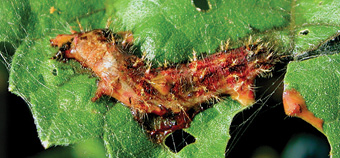
- Figure 20. Thistle caterpillar infected with a baculovirus. (Janet Knodel, NDSU)
This publication is supported in part by the Great Plains Diagnostic Network grant and the Crop Protection and Pest Management Program (grant No. 2017-70006-27144/accession 1013592) of the U.S. Department of Agriculture’s National Institute of Food and Agriculture.



